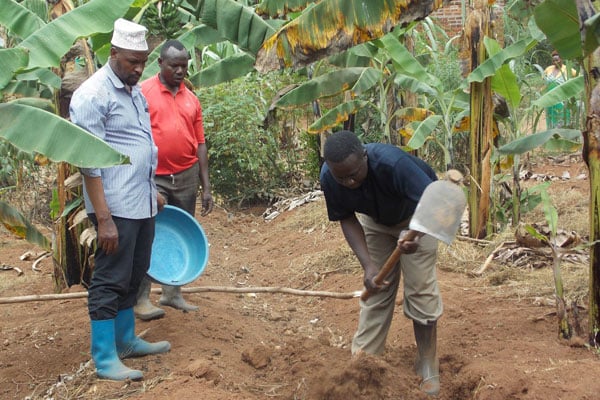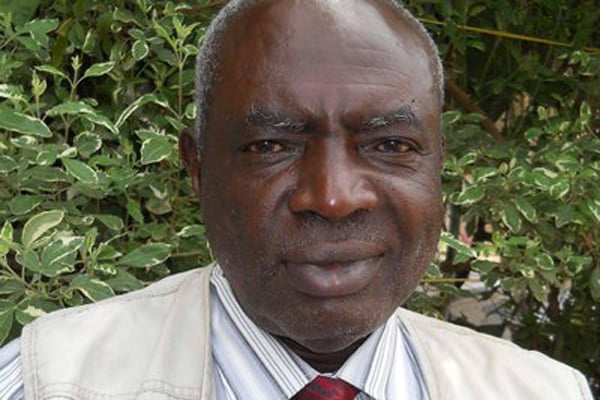Muwanga teaches nature’s way of fighting pests

Disan Muwanga teaches farmers how to make the natural pesticide out of the herbs.
What you need to know:
- He says that when the three are mixed together and put in water and urine for 21 days, the solution is quite effective in killing banana weevils and other pests.
Disan Muwanga who is in charge of promoting agriculture, animal husbandry, fisheries, and natural environment protection in Kabaka’s administrative area of Buddu is a man with a lot of interesting farming ideas.
His official duties include coordinating farmers’ groups in the region and ensuring that they carry out environmentally friendly farming practices.
He must also collect data and whatever other useful information on farming and present it to Buganda Cultural Development Foundation (BUCADEF).
He must also write monthly reports and give them to the Ssaza Chief (Pokino) and to the officer responsible for farming activities in BUCADEF.
He is further charged with establishing and taking care of demonstration gardens of crops such as banana, sweet potato, coffee, and pineapples on the Buganda Kingdom’s land around the Pokino’s office in Masaka City.
“The idea is that people will be encouraged to visit the gardens and to copy best farming practices,” explains Muwanga. “We want to turn the gardens into a learning centre for the farmers in the region.”
How he started
Muwanga who studied Botany, Zoology, and Chemistry at Makerere University Kampala has been conducting research among farmers in the Masaka region and listening to stories about their challenges.
“Most of the challenges have natural solutions and the farmers need not worry about spending money on pesticides all the time,” he says.
He knows a number of locally available herbs that can be used to fight such pests as banana weevils and others. He mentions some of the herbs as Kimyula (Tithonia diversforia), Oluwoko (Phylolaca dodecundra), and Muluku (Tephlozia vogeri).
Making herbs
He teaches farmers how to make the natural pesticide out of the herbs. He says that when the three are mixed together and put in water and urine for twenty-one days, the solution is quite effective in killing banana weevils and other pests. “It is not just a pesticide; it is also a fertiliser since it is made out of organic matter,” goes on to explain.
“Before deciding on what crops to plant in the Pokino’s demonstration gardens we considered what are regarded as the most important and most commonly grown crops for food and cash,” he told Seeds of Gold.
“Otherwise there is no point in people coming here and not finding a single crop of interest to them.” He then went ahead to explain that the Ssaza administration follows Mengo’s campaign of fighting food insecurity and poverty and it was the reason they chose Robusta coffee, banana, sweet potato and pineapple.
The four are actually the most grown crops in the region for both cash and food. Kyannamukaaka, Buwunga, and Kyesiiga Sub-counties are known for growing pineapple.
Demo gardens
Muwanga has said the pineapple demonstration garden which is going to be about an acre will be used to teach farmers how to grow pineapples as a flourishing business on a small piece of land. “They will learn how to apply organic fertiliser to come up with quite large and sweet pineapples that everyone will yarn for.”
He went on to reveal that already planting of Robusta coffee has begun on a plot of three acres. Big holes were already dug and halfway filled with cow dung for planting banana when the rain season begins.
“Before we plant any banana stems we will have to mix all the cow dung with soil,” he explained. “If the plantains are directly planted in cow dung before it is mixed with soil the roots will get into the cow dung when it rains but when the rain stops and sunshine sets in the plantains will most likely dry up and we will lose them.”
Take on soils
He disagrees with those who keep saying that the soil in Buganda has become too old for profitable farming.
“This is just a concept in their minds, but it is wrong,” he responds. According to him the soil must be continuously replenished by burying all dry weeds and any other organic material in the ground. Then after some time they rot and turn into manure for the plants.
Best practices
Burying weeds and grass underground is one of his ways of fighting such banana diseases as Black Sigatoka and Black Leaf Strike Disease.
He says the diseases are a sign to show that the banana roots are too close to the surface. Muwanga who is also a graduate of Kabale National Teachers College uses his teaching skills to demonstrate to farmers how to overcome the challenges of banana production.
He has in the recent weeks been visiting the banana garden of Mr Christopher Lule Kiggundu which he has turned into a flourishing and productive farm by just teaching the farmer how to overcome the banana weevils, Black Sigatoka, Black Leaf Strike Disease, and Banana Bacterial Wilt. For such diseases as Black Sigatoka and Black Leaf Strike Disease keeping the roots well underground is the most preventive according to him. He says this can be achieved by what he calls soil loosening around the stem of the banana plant.
The farmer is advised to dig up the soil, perhaps three feet from the banana stem and burying grass or weeds into the soil.
He says when the grass and weeds rot they become feeding matter for the banana roots and they remain underground feeding instead of coming out to ground surface in search of nutrients. Another way is to bury banana stems in trenches dug across the banana garden which he says also keeps the soil moist.
With regard to banana weevils, Muwanga says the farmer should keep watching out for some black spots on the banana leaves which are often a sign of banana weevils’ presence.
Another symptom of banana weevils according to him is the formation of vertical openings on some of the outer sheathes of the banana stem. “The farmer should carefully pluck off any drying sheath to avoid giving the weevils a natural habitat,” Muwanga says.
“He should also remove all banana stem stumps after the bananas have been harvested. The farmer is further advised not to extend the mulch too close to the banana stem base to deny weevils any chance of multiplication.”
If after taking all the given precautions the weevils persist Muwanga then advises the farmer to apply the herbal pesticide that is his own brain child.
Kiggundu who has been using the “Banana Plantation Herbal Mix” as it is called in his garden says it has been effective in eradicating the banana weevils. He also uses it to soak in tools after using them to cut down banana stems that have been infected with Banana Bacterial Wilt.
Symptoms
The major symptom of banana weevils according to Disan Muwanga is the formation of vertical openings on some of the outer sheathes of the banana stem.




